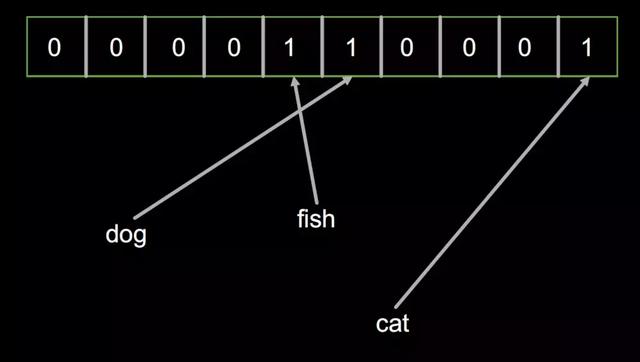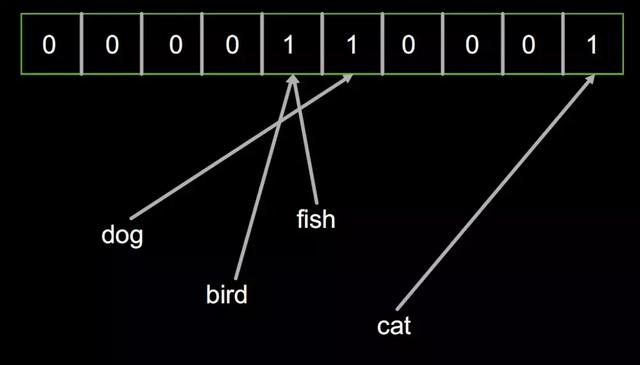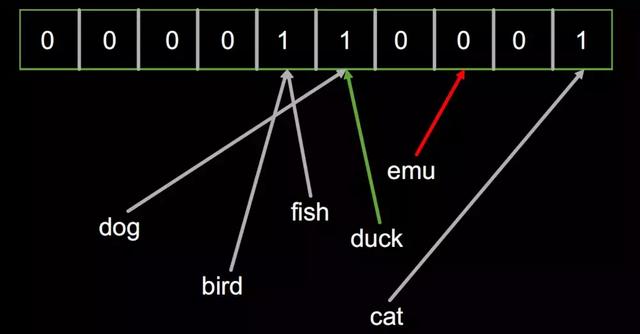搜索是大数据领域里常见的需求。Splunk和ELK分别是该领域在非开源和开源领域里的***。本文利用很少的Python代码实现了一个基本的数据搜索功能,试图让大家理解大数据搜索的基本原理。
布隆过滤器 (Bloom Filter)
***步我们先要实现一个布隆过滤器。
布隆过滤器是大数据领域的一个常见算法,它的目的是过滤掉那些不是目标的元素。也就是说如果一个要搜索的词并不存在与我的数据中,那么它可以以很快的速度返回目标不存在。
让我们看看以下布隆过滤器的代码:
- class Bloomfilter(object):
- """
- A Bloom filter is a probabilistic data-structure that trades space for accuracy
- when determining if a value is in a set. It can tell you if a value was possibly
- added, or if it was definitely not added, but it can't tell you for certain that
- it was added.
- """
- def __init__(self, size):
- """Setup the BF with the appropriate size"""
- self.values = [False] * size
- self.size = size
- def hash_value(self, value):
- """Hash the value provided and scale it to fit the BF size"""
- return hash(value) % self.size
- def add_value(self, value):
- """Add a value to the BF"""
- h = self.hash_value(value)
- self.values[h] = True
- def might_contain(self, value):
- """Check if the value might be in the BF"""
- h = self.hash_value(value)
- return self.values[h]
- def print_contents(self):
- """Dump the contents of the BF for debugging purposes"""
- print self.values
- 基本的数据结构是个数组(实际上是个位图,用1/0来记录数据是否存在),初始化是没有任何内容,所以全部置False。实际的使用当中,该数组的长度是非常大的,以保证效率。
- 利用哈希算法来决定数据应该存在哪一位,也就是数组的索引
- 当一个数据被加入到布隆过滤器的时候,计算它的哈希值然后把相应的位置为True
- 当检查一个数据是否已经存在或者说被索引过的时候,只要检查对应的哈希值所在的位的True/Fasle
看到这里,大家应该可以看出,如果布隆过滤器返回False,那么数据一定是没有索引过的,然而如果返回True,那也不能说数据一定就已经被索引过。在搜索过程中使用布隆过滤器可以使得很多没有***的搜索提前返回来提高效率。
我们看看这段 code是如何运行的:
- bf = Bloomfilter(10)
- bf.add_value('dog')
- bf.add_value('fish')
- bf.add_value('cat')
- bf.print_contents()
- bf.add_value('bird')
- bf.print_contents()
- # Note: contents are unchanged after adding bird - it collides
- for term in ['dog', 'fish', 'cat', 'bird', 'duck', 'emu']:
- print '{}: {} {}'.format(term, bf.hash_value(term), bf.might_contain(term))
结果:
- [False, False, False, False, True, True, False, False, False, True]
- [False, False, False, False, True, True, False, False, False, True]
- dog: 5 True
- fish: 4 True
- cat: 9 True
- bird: 9 True
- duck: 5 True
- emu: 8 False
首先创建了一个容量为10的的布隆过滤器

然后分别加入 ‘dog’,‘fish’,‘cat’三个对象,这时的布隆过滤器的内容如下:

然后加入‘bird’对象,布隆过滤器的内容并没有改变,因为‘bird’和‘fish’恰好拥有相同的哈希。

***我们检查一堆对象('dog', 'fish', 'cat', 'bird', 'duck', 'emu')是不是已经被索引了。结果发现‘duck’返回True,2而‘emu’返回False。因为‘duck’的哈希恰好和‘dog’是一样的。

分词
下面一步我们要实现分词。 分词的目的是要把我们的文本数据分割成可搜索的最小单元,也就是词。这里我们主要针对英语,因为中文的分词涉及到自然语言处理,比较复杂,而英文基本只要用标点符号就好了。
下面我们看看分词的代码:
- def major_segments(s):
- """
- Perform major segmenting on a string. Split the string by all of the major
- breaks, and return the set of everything found. The breaks in this implementation
- are single characters, but in Splunk proper they can be multiple characters.
- A set is used because ordering doesn't matter, and duplicates are bad.
- """
- major_breaks = ' '
- last = -1
- results = set()
- # enumerate() will give us (0, s[0]), (1, s[1]), ...
- for idx, ch in enumerate(s):
- if ch in major_breaks:
- segment = s[last+1:idx]
- results.add(segment)
- last = idx
- # The last character may not be a break so always capture
- # the last segment (which may end up being "", but yolo)
- segment = s[last+1:]
- results.add(segment)
- return results
主要分割
主要分割使用空格来分词,实际的分词逻辑中,还会有其它的分隔符。例如Splunk的缺省分割符包括以下这些,用户也可以定义自己的分割符。
- ] < > ( ) { } | ! ; , ' " * s & ? + %21 %26 %2526 %3B %7C %20 %2B %3D -- %2520 %5D %5B %3A %0A %2C %28 %29
- def minor_segments(s):
- """
- Perform minor segmenting on a string. This is like major
- segmenting, except it also captures from the start of the
- input to each break.
- """
- minor_breaks = '_.'
- last = -1
- results = set()
- for idx, ch in enumerate(s):
- if ch in minor_breaks:
- segment = s[last+1:idx]
- results.add(segment)
- segment = s[:idx]
- results.add(segment)
- last = idx
- segment = s[last+1:]
- results.add(segment)
- results.add(s)
- return results
次要分割
次要分割和主要分割的逻辑类似,只是还会把从开始部分到当前分割的结果加入。例如“1.2.3.4”的次要分割会有1,2,3,4,1.2,1.2.3
- def segments(event):
- """Simple wrapper around major_segments / minor_segments"""
- results = set()
- for major in major_segments(event):
- for minor in minor_segments(major):
- results.add(minor)
- return results
分词的逻辑就是对文本先进行主要分割,对每一个主要分割在进行次要分割。然后把所有分出来的词返回。
我们看看这段 code是如何运行的:
- for term in segments('src_ip = 1.2.3.4'):
- print term
- src
- 1.2
- 1.2.3.4
- src_ip
- 3
- 1
- 1.2.3
- ip
- 2
- =
- 4
搜索
好了,有个分词和布隆过滤器这两个利器的支撑后,我们就可以来实现搜索的功能了。
上代码:
- class Splunk(object):
- def __init__(self):
- self.bf = Bloomfilter(64)
- self.terms = {} # Dictionary of term to set of events
- self.events = []
- def add_event(self, event):
- """Adds an event to this object"""
- # Generate a unique ID for the event, and save it
- event_id = len(self.events)
- self.events.append(event)
- # Add each term to the bloomfilter, and track the event by each term
- for term in segments(event):
- self.bf.add_value(term)
- if term not in self.terms:
- self.terms[term] = set()
- self.terms[term].add(event_id)
- def search(self, term):
- """Search for a single term, and yield all the events that contain it"""
- # In Splunk this runs in O(1), and is likely to be in filesystem cache (memory)
- if not self.bf.might_contain(term):
- return
- # In Splunk this probably runs in O(log N) where N is the number of terms in the tsidx
- if term not in self.terms:
- return
- for event_id in sorted(self.terms[term]):
- yield self.events[event_id]
- Splunk代表一个拥有搜索功能的索引集合
- 每一个集合中包含一个布隆过滤器,一个倒排词表(字典),和一个存储所有事件的数组
- 当一个事件被加入到索引的时候,会做以下的逻辑
- 为每一个事件生成一个unqie id,这里就是序号
- 对事件进行分词,把每一个词加入到倒排词表,也就是每一个词对应的事件的id的映射结构,注意,一个词可能对应多个事件,所以倒排表的的值是一个Set。倒排表是绝大部分搜索引擎的核心功能。
- 当一个词被搜索的时候,会做以下的逻辑
- 检查布隆过滤器,如果为假,直接返回
- 检查词表,如果被搜索单词不在词表中,直接返回
- 在倒排表中找到所有对应的事件id,然后返回事件的内容
我们运行下看看把:
- s = Splunk()
- s.add_event('src_ip = 1.2.3.4')
- s.add_event('src_ip = 5.6.7.8')
- s.add_event('dst_ip = 1.2.3.4')
- for event in s.search('1.2.3.4'):
- print event
- print '-'
- for event in s.search('src_ip'):
- print event
- print '-'
- for event in s.search('ip'):
- print event
- src_ip = 1.2.3.4
- dst_ip = 1.2.3.4
- -
- src_ip = 1.2.3.4
- src_ip = 5.6.7.8
- -
- src_ip = 1.2.3.4
- src_ip = 5.6.7.8
- dst_ip = 1.2.3.4
是不是很赞!
更复杂的搜索
更进一步,在搜索过程中,我们想用And和Or来实现更复杂的搜索逻辑。
上代码:
- class SplunkM(object):
- def __init__(self):
- self.bf = Bloomfilter(64)
- self.terms = {} # Dictionary of term to set of events
- self.events = []
- def add_event(self, event):
- """Adds an event to this object"""
- # Generate a unique ID for the event, and save it
- event_id = len(self.events)
- self.events.append(event)
- # Add each term to the bloomfilter, and track the event by each term
- for term in segments(event):
- self.bf.add_value(term)
- if term not in self.terms:
- self.terms[term] = set()
- self.terms[term].add(event_id)
- def search_all(self, terms):
- """Search for an AND of all terms"""
- # Start with the universe of all events...
- results = set(range(len(self.events)))
- for term in terms:
- # If a term isn't present at all then we can stop looking
- if not self.bf.might_contain(term):
- return
- if term not in self.terms:
- return
- # Drop events that don't match from our results
- results = results.intersection(self.terms[term])
- for event_id in sorted(results):
- yield self.events[event_id]
- def search_any(self, terms):
- """Search for an OR of all terms"""
- results = set()
- for term in terms:
- # If a term isn't present, we skip it, but don't stop
- if not self.bf.might_contain(term):
- continue
- if term not in self.terms:
- continue
- # Add these events to our results
- results = results.union(self.terms[term])
- for event_id in sorted(results):
- yield self.events[event_id]
利用Python集合的intersection和union操作,可以很方便的支持And(求交集)和Or(求合集)的操作。
运行结果如下:
- s = SplunkM()
- s.add_event('src_ip = 1.2.3.4')
- s.add_event('src_ip = 5.6.7.8')
- s.add_event('dst_ip = 1.2.3.4')
- for event in s.search_all(['src_ip', '5.6']):
- print event
- print '-'
- for event in s.search_any(['src_ip', 'dst_ip']):
- print event
- src_ip = 5.6.7.8
- -
- src_ip = 1.2.3.4
- src_ip = 5.6.7.8
- dst_ip = 1.2.3.4
总结
以上的代码只是为了说明大数据搜索的基本原理,包括布隆过滤器,分词和倒排表。如果大家真的想要利用这代码来实现真正的搜索功能,还差的太远。




























